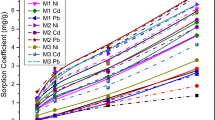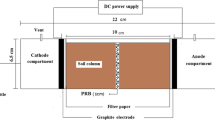Abstract
This paper presents the experimental findings of electrokinetic (EK) studies conducted to remove cadmium (Cd++) and copper (Cu++) present together as contaminants in clayey soil. Competitive sorption between cadmium and copper has been studied, which provides an insight into selection of Cd++ and Cu++ concentrations for maximum contamination of soil in the EK study. To explore the effect of pH on the desorption of both Cd++ and Cu++ and to compare the efficacy of different agents in enhancing the removal of these ions during the EK remediation process, the desorption studies have also been conducted using ammonium citrate (1 M), sodium citrate (1 M) and non-ionic surfactant Tween-20 (0.2 % v/v) at pH 2, pH 7, and pH 12. It was found that maximal sorption capacity of the soil for Cd++ and Cu++ was 8.34 and 12.1 mg g−1, respectively. The desorption of both Cd++ and Cu++ influenced by pH for all desorbing agents is considered in the study. Overall desorption values for both Cd++ and Cu++ have been observed to be higher when ammonium citrate (1 M) was used as desorbing agent in the study. The results indicate the possibility of competition of complexation of Cd++ and Cu++ leading to desorption mechanism in the presence of desorbing agents. The EK tests on the Cd++ and Cu++ contaminated soil are carried out at a voltage of 35 V (1.0 V/cm) DC for 5 days. Sequential extraction experiments were conducted to determine fractionation of Cd++ and Cu++ in the EK-treated soil using deionized water at pH values of 2, 7 and 12. It is observed that current, electroosmotic flow and mobilization of Cd++ and Cu++ depend on pH, zeta potential (ς) and specific conductance. Removal of these heavy metals was observed to be higher when ammonium citrate was used both for saturation as well as flushing solution during EK process.















Similar content being viewed by others
Abbreviations
- AC:
-
Ammonium citrate
- SC:
-
Sodium citrate
- F:
-
Non-ionic surfactant tween-20
- Cd++ :
-
Cadmium
- Cu++ :
-
Copper
- EK:
-
Electrokinetic
- VS:
-
Virgin soil
- CdCuS:
-
Soil contaminated with Cd++ and Cu++ together
- EKCdCuD:
-
Electrokinetic remediation of Cd++ and Cu++ contaminated soil using de-ionized water
- EKCdCuF:
-
Electrokinetic remediation of Cd++ and Cu++ contaminated soil using Tween-20
- EKCdCuSC:
-
Electrokinetic remediation of Cd++ and Cu++ contaminated soil using sodium citrate
- EKCdCuAC:
-
Electrokinetic remediation of Cd++ and Cu++ contaminated soil using ammonium citrate
- EKCdCuAA:
-
Electrokinetic remediation of Cd++ and Cu++ contaminated soil saturated with ammonium citrate and also, the same being used as flushing agent
- EDTA:
-
Ethylenediaminetetraacetic acid
- k e :
-
EO permeability (cm2/V-s)
- XRD:
-
X-ray diffraction
- XRF:
-
X-ray fluorescence
References
Acar YB, Alshawabkeh AN (1993) Principles of electrokinetic remediation. Environ Sci Technol 27(13):2638–2647
Adriano DC (2001) Trace elements in terrestrial environments. Biogeochemistry, bioavailability and risks of metals. Springer, New York
Almeira, JO, Peng C, Li PP (2010) Effect of electrode configuration on the distribution of Cu during electrokinetic soil remediation. J Korean Soc Urban Environ 10:169–177
Anderson RJ, Davies BE (1980) Dental caries prevalence and trace elements in soil, with special reference to lead. J Geol Soc Lond 137(5):547–558
Asadi A, Moayedi H, Huat BBK, Parsaie A (2011) Probable electrokinetic phenomena in tropical peat: a review. Int J Phys Sci 6(9):2184–2188
Aydinalp C, Marinova S (2003) Distribution and forms of heavy metals in some agricultural soils. Pol J Environ Stud 12(5):629–633
Brynhildrem L, Rosswall T (1989) Effects of copper, magnesium and zinc on decomposition of citrate by a Klebsiella Sp. Appl Environ Microbiol 55:1375–1379
Castellote M, Botija S (2011) Electrokinetic decontamination of heavy metals in construction materials: contribution of the different parameters to the global efficiency. J Appl Electrochem 41:695–703
Chang PW, Tan YC, Wang IS (2008) On-farm remediation and fertility enhancement of cadmium-contaminated silt loam by electrokinetic treatment process in Taiwan. Irrig Drain 57(2):187–201
Cheung CW, Porter JF, McKay G (2000) Elovich equation and modified second- order equation for adsorption of cadmium ions onto bone char. J Chem Technol Biotechnol 75(11):963–970
Dudley LM, McLean JE, Sims RC, Jurinak JJ (1988) Sorption of copper and cadmium from the water soluble fraction of an acid mine waste by two calcareous soils. Soil Sci 145(3):207–214
Dudley LM, McLean JE, Furst TH, Jurinak JJ (1991) Sorption of Cd and Cu from an acid mine waste extract by two calcareous soils: column studies. Soil Sci 151(2):121–135
Gao YZ, He JZ, Ling WT, Hu HQ, Liu F (2003) Effects of organic acids on copper and cadmium desorption from contaminated soils. Environ Int 29(5):613–618
Glusker JP (1980) Citrate conformation and chelation: enzymatic implications. Acc Chem Res 13(10):345–352
Gray CW, McLaren RG, Roberts AHC, Condron LM (1998) Sorption and desorption of cadmium from some New Zealand soils: effect of pH and contact time. Aust J Soil Res 36:199–216
Huang J-Y, Liao W-P, Lai S-M (2013) Removal of 2,4-dichlorophenol and pentachlorophenol from aqueous media by electrochemical process. Environ Earth Sci 68(8):2281–2288
Inskeep WP, Baham J (1983) Competitive complexation of Cd(II) and Cu(II) by water-soluble organic ligands and Na-Montmorillonite. Soil Sci Soc Am J 47(6):1109–1115
Kalandadze B (2003) Influence of the ore mining and processing enterprise on soil types in adjoining areas. Agron Res 1(2):131–137
Kaya A, Yukselen Y (2005a) Zeta potential of clay minerals and quartz contaminated by heavy metals. Can Geotech J 42(5):1280–1289
Kaya A, Yukselen Y (2005b) Zeta potential of soils with surfactants and its relevance to electrokinetic remediation. J Hazard Mater B 120:119–126
Krishna AK, Govil PK (2007) Soil contamination due to heavy metals from an industrial area of Surat, Gujarat, Western India. Environ Monit Assess 124:263–275
Kumar MP, Reddy TM, Nithila P, Reddy SJ (2005) Distribution of toxic trace metals Zn, Cd, Pb, and Cu in Tirupati soils, India. Soil Sedim Contam Int J 14(6):471–478
Lakatos J, Ulmanu M, Anger I, Snape CE (2003) Comparison of sorption of Cu (II), Cr(III) and Cr(VI) on inorganic and organic sorbents. In: Proceedings, of the 1st international conference on environmental research and assessment, Bucharest, pp 123–132
Loganathan P, Mackay AD, Lee J, Hedley MJ (1995) Cadmium distribution in hill pastures as influenced by 20 years of phosphate fertilizer application and sheep grazing. Aust J Soil Res 33(5):859–871
McGrath SP (1987) Long-term studies of metal transfers following application of sewage sludge. In: Coughtrey PJ, Martin MH, Unsworth MH (eds) Pollutants transport and fate in ecosystems. Blackwell Scientific Publications, London, pp 301–317
Nystrøm GM, Ottosen LM, Villumsne A (2005) Test of experimental set-ups for electrodialytic removal of Cu, Zn, Pb and Cd from different contaminated harbour sediments. Eng Geol 77:349–357
Ortuño-López MB, Sotelo-Lerma M, Mendoza-Galván A, Ramírez-Bon R (2004) Chemically deposited CdS films in an ammonia free cadmium–sodium citrate system. Thin Solid Films 457(2):278–284
Ottosen LM, Hansen HK, Hansen L, Kliem BK, Bech-Nielsen G, Villumsen A (1998) Electrodialytic soil remediation: improved conditions and acceleration of the process by addition of desorbing agents to the soil. In: Proceedings, of the sixth international FZK/TNO conference on contaminated soil, contaminated soil ‘98. vol 1, pp 471–478. Edinburgh
Ottosen LM, Hansen HK, Ribeiro AB, Villumsen A (2001) Removal of Cu, Pb and Zn in an applied electric field in calcareous and non-calcareous soils. J Hazard Mater B 85:291
Ottosen LM, Pedersen AJ, Ribeiro AB, Hansen HK (2005) Case study on the strategy and application of enhancement solutions to improve remediation of soils contaminated with Cu, Pb and Zn by means of electrodialysis. Eng Geol 77:317–329
Paramkusam BR, Srivastava RK, Dwivedi SB (2011) Experimental studies on heavy metals extraction from contaminated soil using alkaline chelate, ammonium citrate during electrokinetic process. ASCE J Hazard Toxic Radioact Waste Manag 15(4):296–304
Pedersen AJ (2002) Evaluation of assisting agents for electrodialytic removal of Cd, Pb, Zn, Cu and Cr from MSWI fly ash. J Hazard Mater B95:185–198
Pedersen AJ (2003) Characterization and electrodialytic treatment of wood combustion fly ash for the removal of cadmium. Bimass Bioenergy 25:447–458
Peng C, Almeira JO, Gu Q (2013) Effect of electrode configuration on pH distribution and heavy metal ions migration during soil electrokinetic remediation. Environ Earth Sci 69(1):257–265
Puls RW, Bohn HL (1988) Sorption of cadmium, nickel, and zinc by kaolinite and montmorillonite suspensions. Soil Sci Soc Am J 52(5):1289–1292
Ramachandran V, Souza TJD (1999) Adsorption of cadmium by Indian soils. Water Air Soil Pollut 111:225–234
Reddy KR (2002) Assessment of remediation of contaminated site. In: Proceedings, of the Indian geotechnical conference on geotechnical engineering: environmental challenges, vol II, pp 735–746. Allahabad
Reddy KR, Chinthamreddy S, Al-Hamdan A (2001) Synergistic effects of multiple metal contaminants on electrokinetic remediation of soils. Remediat Summ 11(3):85–109
Reddy KR, Cameselle C, Ala P (2010) Integrated electrokinetic-soil flushing to remove mixed organic and metal contaminants. J Appl Electrochem 40:1269–1279
Sivapullaiah PV, Prakash BSN (2007) Electroosmotic flow behaviour of metal contaminated expansive soil. J Hazard Mater 143:682–689
Srivastava P, Singh B, Angove M (2005) Competitive adsorption behavior of heavy metals on kaolinite. J Colloid Interface Sci 290(1):28–38
Srivastava RK, Tiwari RP, Bala Ramudu P (2008) Enhanced removal of cadmium from alkaline soil by electromigration. Land Contam Reclam 16(3):199–212
Taylor MD (1997) Accumulation of cadmium derived from fertilisers in New Zealand soils. Sci Total Environ 208(1):123–126
Wu J, Lu J, Chen TH, He Z, Su Y, Jin X, Yao XY (2010) In situ biotreatment of acidic mine drainage using straw as sole substrate. Environ Earth Sci 60(2):421–429
Yadav IC, Devi NL, Mohan D, Shihua Q, Singh S (2013) Assessment of groundwater quality with special reference to arsenic in Nawalparasi district, Nepal using multivariate statistical techniques. Environ Earth Sci. doi:10.1007/s12665-013-2952-4
Yang GCC, Long YW (1999) Removal and degradation of phenol in a saturated flow by in situ electrokinetic remediation and fenton-like process. J Hazard Mater 69(3):259–271
Yuan S, Xi Z, Jiang Y, Wan J, Wu C, Zheng Z, Lu X (2007) Desorption of copper and cadmium from soils enhanced by organic acids. Chemosphere 68:1289–1297
Zhu S, Zhang J, Dong T (2009) Removal of fluorine from contaminated field soil by anolyte enhanced electrokinetic remediation. Environ Earth Sci 59(2):379–384
Acknowledgments
The authors acknowledge the help extended by the Wadia Institute of Himalayan Geology, Dehradun, India, for XRF analysis; Nanophosphor Application Center, University of Allahabad, Allahabad for XRD analysis; and Department of Science and Technology (Govt. of India) for providing Zeta Meter 4.0 at Civil Engineering Department, Indian Institute of Technology (Banaras Hindu University), Varanasi.
Author information
Authors and Affiliations
Corresponding author
Rights and permissions
About this article
Cite this article
Paramkusam, B.R., Srivastava, R.K. & Mohan, D. Electrokinetic removal of mixed heavy metals from a contaminated low permeable soil by surfactant and chelants. Environ Earth Sci 73, 1191–1204 (2015). https://doi.org/10.1007/s12665-014-3474-4
Received:
Accepted:
Published:
Issue Date:
DOI: https://doi.org/10.1007/s12665-014-3474-4




